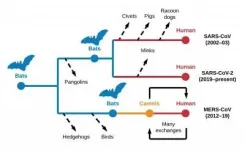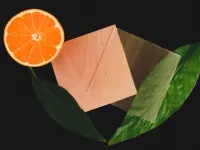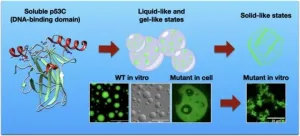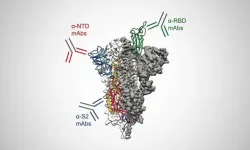Study finds potential therapeutic target for pediatric acute myeloid leukemia
Novel gene variants may point the way to precision medicine for AML in children
2021-05-04
(Press-News.org) ORLANDO, Fla. (May 3, 2021) - Researchers have identified a gene expressed in children with acute myeloid leukemia (AML) that could serve as a new immunotherapy treatment target, according to a new study published today in Blood Advances, a journal of the American Society of Hematology. The study, co-authored by researchers with Nemours Children's Health System, outlines the process and potential path for new immunotherapy drugs that improve survival and reduce treatment-related toxicity in children with AML.
Leukemia is the most common cancer in children and teens, and AML accounts for nearly one-fourth of those cases. AML is a fast-growing cancer that typically starts in immature bone marrow cells.
"Using genomic sequencing data, we identified novel targets for children's cancer and worked with collaborators to engineer new therapies for children with AML, rather than repurpose drugs from the adult cancer realm that don't work well in children," said E. Anders Kolb, MD, director of Nemours' Center for Childhood Cancer Research and a senior author of the study.
The researchers obtained genomic data from more than 2,000 pediatric patients with leukemia, to identify associated gene variants. Through genomic sequencing, they found that the gene mesothelin (MSLN) is abnormally expressed in more than one-third of childhood and young adult AML cases but was absent in normal bone marrow cells.
After this discovery, the researchers chose new immunotherapy drugs that would target MSLN to test in cell lines and animal models, to gauge pre-clinical effectiveness of leukemia therapies. Two experimental immunotherapy drugs were tested: anetumab ravtansine (Bayer), which is being tested in adult cancers, and a new compound, anti-MSLN-DGN462 (ImmunoGen). Each drug, in lab testing and in mouse models, produced potent destruction of leukemia cells. These drugs belong to a new class of cancer treatments known as anti-body drug conjugates (ADCs), which combine an antibody with a cancer-killing toxin. The antibody targets specific types of cancer cells and delivers the toxin directly to them, minimizing damage to healthy cells.
"We are working to show a proof of principle that we can create custom therapies for pediatric malignancies and turn the drugs we're testing in the lab into clinical trials," said Sonali P. Barwe, PhD, the study's co-lead author and head of the Preclinical Leukemia Testing Laboratory in Nemours' Center for Childhood Cancer Research.
The rapid evolution of genomic sequencing funded by the National Institutes of Health has led to the identification of new gene targets that are relevant for a significant number of patients. In addition, local organizations, such as the Leukemia Research Foundation of Delaware, have funded efforts like this study by Nemours to find new treatments.
INFORMATION:
About Nemours Children's Health System
Nemours is an internationally recognized children's health system that owns and operates the Nemours/Alfred I. duPont Hospital for Children in Wilmington, Del., and Nemours Children's Hospital in Orlando, Fla., along with outpatient facilities in five states, delivering pediatric primary, specialty and urgent care. Nemours also powers the world's most-visited website for information on the health of children and teens, KidsHealth.org and offers on-demand, online video patient visits through Nemours CareConnect.
Established as The Nemours Foundation through the legacy and philanthropy of Alfred I. duPont, Nemours provides pediatric clinical care, research, education, advocacy, and prevention programs to families in the communities it serves.
ELSE PRESS RELEASES FROM THIS DATE:
2021-05-04
Coronavirus (CoVs) infection in animals and humans is not new. The earliest papers in the scientific literature of coronavirus infection date to 1966. However, prior to SARS-CoV, MERS-CoV, and SARS-CoV-2, very little attention had been paid to coronaviruses.
Suddenly, coronaviruses changed everything we know about personal and public health, and societal and economic well-being. The change led to rushed analyses to understand the origins of coronaviruses in humans. This rush has led to a thus far fruitless search for intermediate hosts (e.g., civet in SARS-CoV and pangolin in SARS-CoV-2) rather than focusing on the important work, which has always been surveillance of ...
2021-05-04
When was the last time you repainted your car? Redesigned your coffee mug collection? Gave your shoes a colorful facelift?
You likely answered: never, never, and never. You might consider these arduous tasks not worth the effort. But a new color-shifting "programmable matter" system could change that with a zap of light.
MIT researchers have developed a way to rapidly update imagery on object surfaces. The system, dubbed "ChromoUpdate" pairs an ultraviolet (UV) light projector with items coated in light-activated dye. The projected light alters the reflective properties of the dye, creating colorful new images in just a few minutes. The advance could accelerate product development, enabling product designers to churn through ...
2021-05-04
Since it was first introduced in 2016, transparent wood has been developed by researchers at KTH Royal Institute of Technology as an innovative structural material for building construction. It lets natural light through and can even store thermal energy.
The key to making wood into a transparent composite material is to strip out its lignin, the major light-absorbing component in wood. But the empty pores left behind by the absence of lignin need to be filled with something that restores the wood's strength and allows light to permeate.
In earlier versions of the composite, researchers at KTH's Wallenberg Wood Science Centre used fossil-based polymers. Now, the researchers have successfully tested an eco-friendly alternative: limonene acrylate, a monomer made ...
2021-05-04
Cancer has been recently shown to be affected by protein clusters, particularly by the aggregation of mutant variants of the tumor suppressor protein p53, which are present in more than half of malignant tumors. However, how the aggregates are formed is not yet fully understood. The understanding of this process is expected to provide new therapeutic tools able to prevent proteins to clump and cancer progression.
In Brazil, researchers at the Federal University of Rio de Janeiro have identified a key mechanism behind the mutant p53 aggregation process, linked to cancer pathology, opening new paths for the development of novels ...
2021-05-04
BAR HARBOR, MAINE — Our kidneys are charged with the extraordinary task of filtering about 53 gallons of fluid a day, a process that depends on podocytes, tiny, highly specialized cells in the cluster of blood vessels in the kidney where waste is filtered that are highly vulnerable to damage.
In research at the MDI Biological Laboratory in Bar Harbor, Maine, a team led by Iain Drummond, Ph.D., director of the Kathryn W. Davis Center for Regenerative Biology and Aging, has identified the signaling mechanisms underlying podocyte formation, or morphogenesis. The discovery opens the door to ...
2021-05-04
A team of University of Alberta researchers has discovered a way to use 3-D bioprinting technology to create custom-shaped cartilage for use in surgical procedures. The work aims to make it easier for surgeons to safely restore the features of skin cancer patients living with nasal cartilage defects after surgery.
The researchers used a specially designed hydrogel--a material similar to Jell-O--that could be mixed with cells harvested from a patient and then printed in a specific shape captured through 3-D imaging. Over a matter of weeks, the material is cultured in a lab to become functional cartilage.
"It takes a lifetime to make cartilage in an individual, while this method takes about four weeks. So you still expect ...
2021-05-04
Metallacages prepared via coordination-driven self-assembly have received extensive attention because of their three-dimensional layout and cavity-cored nature. The construction of light-emitting materials employing metallacages as a platform has also gained significant interest due to their good modularity in photophysical properties, which bring emerging applications in fields as diverse as sensing, biomedicine, and catalysis.
However, the luminescence efficiency of conventional luminophores significantly decreases in the aggregate state because they encounter unfavorable aggregation-caused quenching (ACQ). Therefore, it was quite a challenge to fabricate light-emitting metallacages with high luminescence efficiency in various physical states.
In 2001, Tang's group ...
2021-05-04
The most complete picture yet is coming into focus of how antibodies produced in people who effectively fight off SARS-CoV-2 work to neutralize the part of the virus responsible for causing infection. In the journal Science, researchers at The University of Texas at Austin describe the finding, which represents good news for designing the next generation of vaccines to protect against variants of the virus or future emerging coronaviruses.
Previous research focused on one group of antibodies that target the most obvious part of the coronavirus's spike protein, called the receptor-binding domain (RBD). Because the RBD is the part of the spike that attaches directly to human cells and enables the virus to infect them, ...
2021-05-04
New York, NY (May 4, 2021) - A powerful, long-term study from WCS adds scientific backing for global calls for conserving 30 percent of the world's ocean. The studied no-take marine protected areas (MPAs) increased the growth of fish populations by 42 percent when fishing was unsustainable in surrounding areas, achieving the benefits of stable and high production of fish populations for fishers, while protecting threatened ecosystems.
The study recorded fish catches for 24-years across a dozen fish landing sites within two counties in Kenya, which allowed scientists to evaluate the long-term impacts of two different fisheries management methods. While one county ...
2021-05-04
Harsh prison sentences for juvenile crimes do not reduce the probability of conviction for violent crimes as an adult, and actually increase the propensity for conviction of drug-related crimes, finds a new study by economists at UC Riverside and the University of Louisiana. Harsh juvenile sentences do reduce the likelihood of conviction for property crimes as an adult. But the increase in drug-related crimes cancels out any benefit harsh sentences might offer, researchers found.
"Juvenile incarceration is a double-edged sword which deters future property crimes but makes drug convictions more likely in adulthood. Thus, it's hard to make firm policy recommendations ...
LAST 30 PRESS RELEASES:
[Press-News.org] Study finds potential therapeutic target for pediatric acute myeloid leukemia
Novel gene variants may point the way to precision medicine for AML in children







